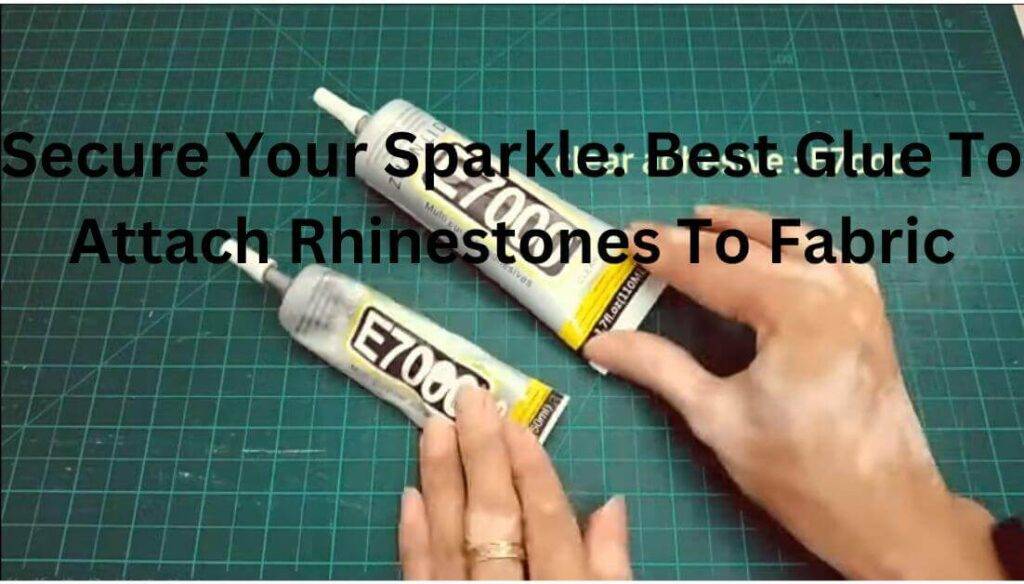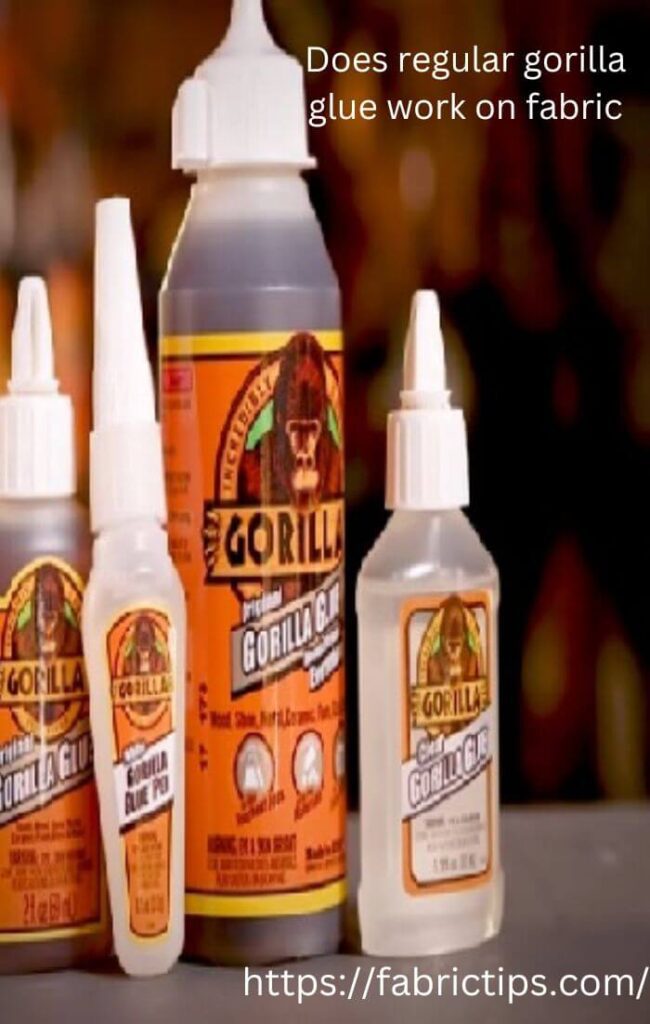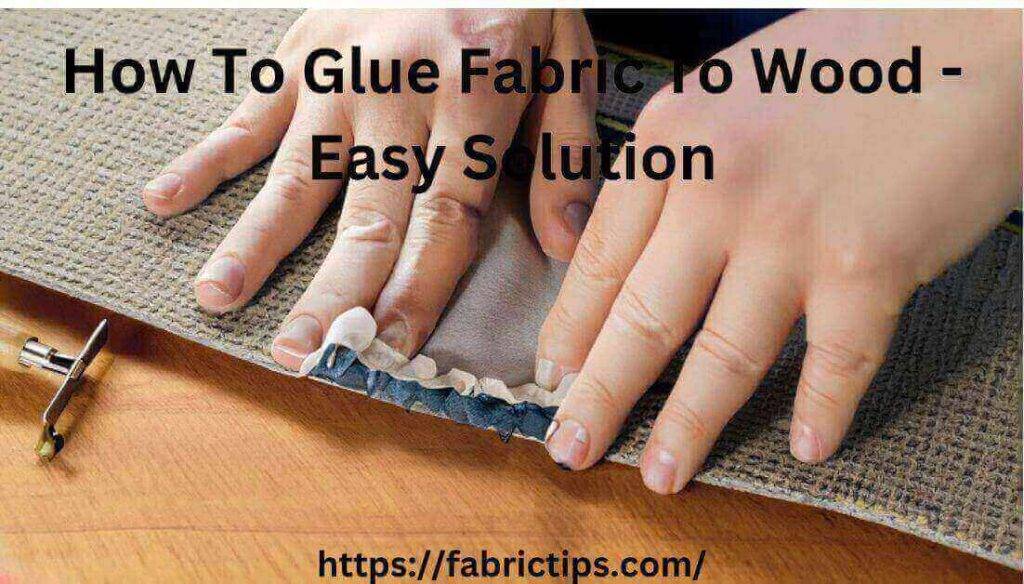Last Updated on December 13, 2025 by Wahid
For designers, DIY enthusiasts, and crafters alike, ensuring that each gem remains securely in place through wear and tear is a testament to their craftsmanship. An ideal adhesive not only provides a strong hold but also maintains the integrity and appearance of the fabric and stones. Whether it’s for dance costumes, fashion garments, or bespoke accessories, the right glue ensures that your work retains its dazzling allure from the first fitting to the final curtain call.
In this comprehensive guide, we’ll navigate the sticky world of adhesives to uncover the best glue to attach rhinestones to fabric. We’ll consider factors such as fabric type, flexibility, durability, and finish, ensuring that your creations not only shine bright but stand the test of time.
Understanding Rhinestone Adhesives
Choosing the right glue for securing rhinestones to fabric is critical not only for the durability of the decorative elements but also for the integrity and functionality of the fabric itself. There are various types of adhesives available that cater to different needs, ranging from temporary to permanent solutions, each with unique properties that can impact the final outcome of your project.
Types Of Fabric Glue Suitable For Rhinestones:
- Permanent Fabric Glue: This is the most common choice for attaching rhinestones that are meant to last. It’s formulated to withstand washing and regular wear, making it ideal for clothing and accessories that will be used repeatedly.
- Temporary Fabric Glue: Used for placements that may need adjustment or for applications where the rhinestones are not intended to be a permanent feature. Temporary glues can be washed out or will lose their tackiness over time.
- Water-Resistant Rhinestone Glue: For fabrics that will be exposed to moisture, water-resistant glues are essential. These adhesives will hold the rhinestones in place even when the fabric is submerged or exposed to heavy moisture.
Key Properties Of A Good Rhinestone Glue:
- Flexibility: A glue that retains flexibility after drying is crucial, especially for fabrics that stretch or move. The adhesive should allow the fabric to drape and fold without causing the rhinestones to pop off.
- Drying Time: The time it takes for glue to set is important to consider. Some projects may benefit from a quick-drying adhesive, while others might need a glue that allows for repositioning of stones before setting completely.
- Clarity: A clear-drying glue ensures that the brilliance of the rhinestones isn’t diminished by visible adhesive. It should dry transparently, without clouding or yellowing over time.
- Strength: The bond strength is essential for the longevity of the embellishment. A strong adhesive prevents rhinestones from falling off with use.
- Non-Toxicity: Especially important for clothing and wearable accessories, non-toxic glues ensure safety for the wearer and the environment.
- Ease of Use: The best rhinestone glue should be easy to apply, with options for precision such as fine tips or syringes, allowing for detailed work without mess.
In order to select a glue for attaching rhinestones to fabric, crafters and designers need to understand these adhesive properties. Whether it’s a garment that will undergo the rigors of performance or a fashion piece for a night out, the adhesive plays a pivotal role in the durability and appearance of the finished product. Keep in mind these characteristics to choosing an adhesive that will make your design not only sparkle but last.
Top Glues For Rhinestone Application
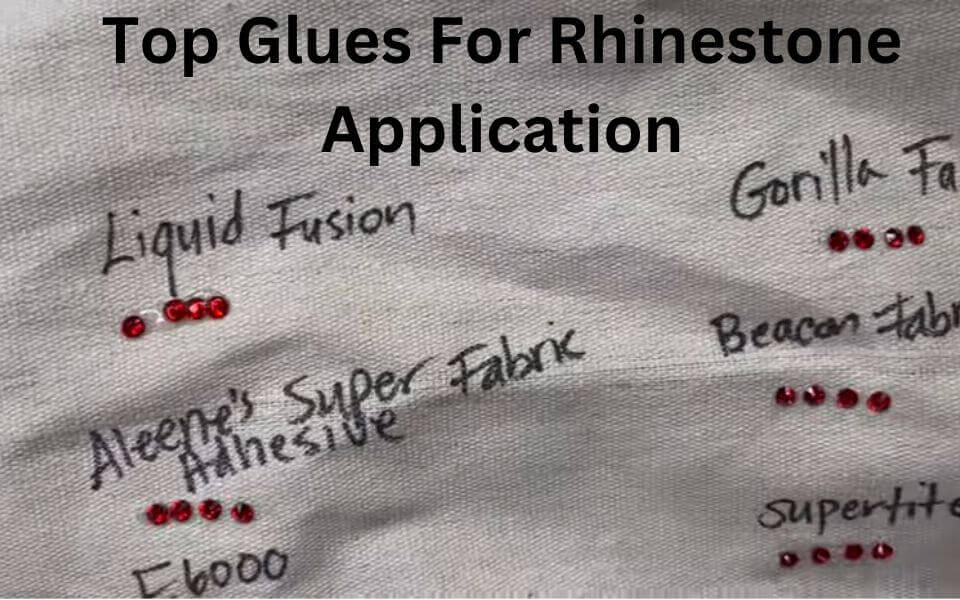
When it comes to embellishing fabrics with rhinestones, the adhesive you choose is as crucial as the jewels themselves. To help you select the best glue to attach rhinestones to fabric, we’ve compiled a comparison chart of the top fabric glues. Thus, taking into account their brand reputation, adhesive type, drying times, and other notable features.
Comparison Chart of Top Fabric Glues for Rhinestones:
| Brand | Type | Drying Time | Features |
| E6000 Fabri-Fuse | Permanent | 3-4 hours | Dries clear, machine washable |
| Gem-Tac Permanent Adhesive | Permanent | 1 hour | Non-toxic, dries clear |
| Aleene’s Jewel-It Embellishing Glue | Permanent | 24 hours | Great for heavy use, clear drying |
| Beacon Gem-Tac Permanent Adhesive | Permanent | 2 hours | Non-toxic, water-proof after drying |
| Tear Mender Instant Fabric and Leather Adhesive | Permanent | 3 minutes | Flexible, UV resistant |
Top Recommended Glues For Secure Rhinestone Attachment:
- E6000 Fabri-Fuse
- This glue is renowned for its industrial-strength hold and flexibility, which is essential when working with fabrics that move. The fact that it dries clear and remains machine washable after curing makes it a favorite among costume designers and craft enthusiasts.
- Gem-Tac Permanent Adhesive
- Specifically formulated for gems and rhinestones, Gem-Tac’s non-toxic formula is a go-to for those who prioritize safety and ease of use. Its fast drying time allows for quick project completion, while the clear drying ensures that the rhinestones’ sparkle is the star of the show.
- Aleene’s Jewel-It Embellishing Glue
- Aleene’s offers a reliable bond that’s perfect for heavy use items. While it has a longer drying time, this allows for adjustments during the crafting process, making it forgiving for intricate designs.
- Beacon Gem-Tac Permanent Adhesive
- Beacon’s Gem-Tac is lauded for its water-resistant properties post-drying, making it suitable for items that might face moisture. It also adheres quickly to a variety of surfaces without yellowing over time.
- Tear Mender Instant Fabric and Leather Adhesive
- When time is of the essence, Tear Mender’s instant adhesive properties are unmatched. The bond is almost immediate, and the added UV resistance is a unique feature that protects fabrics and stones when exposed to sunlight.
Each of these adhesives brings something unique to the table, but they all ensure that your rhinestones stay in place, maintaining the allure and beauty of your fabric creations. When choosing the best glue to attach rhinestones to fabric, consider the nature of your project, the type of fabric, and the conditions the finished product will encounter.
Attention & Precautions When Using Glue to Attach Rhinestones To Fabric

Attaching rhinestones to fabric can transform an ordinary item into a dazzling statement piece. However, working with adhesives requires careful attention and adherence to certain precautions to ensure a successful and safe application. Below are some important considerations to bear in mind:
Attention:
- Read Instructions: Always read the manufacturer’s instructions for your chosen adhesive. Each glue has its specific application methods and drying times.
- Fabric Type: Consider the type of fabric you are working with. Some adhesives are formulated for stretchy materials, while others are better suited for more rigid fabrics.
- Rhinestone Material: The backing of the rhinestone can react differently to various glues. Ensure that the glue you select is compatible with the rhinestone material, whether it be glass, crystal, or plastic.
- Test First: Before starting your project, do a patch test. Apply a few rhinestones with the glue onto a scrap piece of the same fabric to check for any adverse reactions.
- Precision: Use a toothpick, a fine-tip applicator, or a specialized rhinestone setter for precise glue application. This helps prevent excess glue from smearing on the fabric or the top of the rhinestone.
Precautions:
- Ventilation: Work in a well-ventilated area to avoid inhaling fumes, which can be harmful.
- Skin Protection: Avoid skin contact with the glue. Wear gloves if necessary, especially if you have sensitive skin or allergies.
- Eye Safety: Be cautious not to splash glue into your eyes. Keep a safe distance between your face and your work.
- Glue Storage: Store glue in a cool, dry place away from children and pets. Some fabric adhesives can be hazardous if ingested or improperly handled.
- Clean Up Spills: If you spill glue on your workspace, clean it up immediately with a damp cloth (if water-soluble) or according to the glue manufacturer’s recommendations.
- Curing Time: Allow the glue to cure fully before wearing or washing the item. This may take anywhere from 24 to 72 hours, depending on the adhesive used.
- Wash Care: Once cured, if the fabric is washable, turn the garment inside out before washing to protect the rhinestones and use a gentle cycle to preserve the adhesive bond.
If you pay close attention to these aspects and take the necessary precautions, you can ensure a successful and hazard-free application of rhinestones to your fabric. Whether you’re working on a one-off project or multiple items, always prioritize safety and the specific needs of your materials to achieve the best results with the best glue to attach rhinestones to clothing.
See Other Post: Does Regular Gorilla Glue Work On Fabric? [In-Depth Explanation]
How To Apply Glue To Rhinestones And Fabric
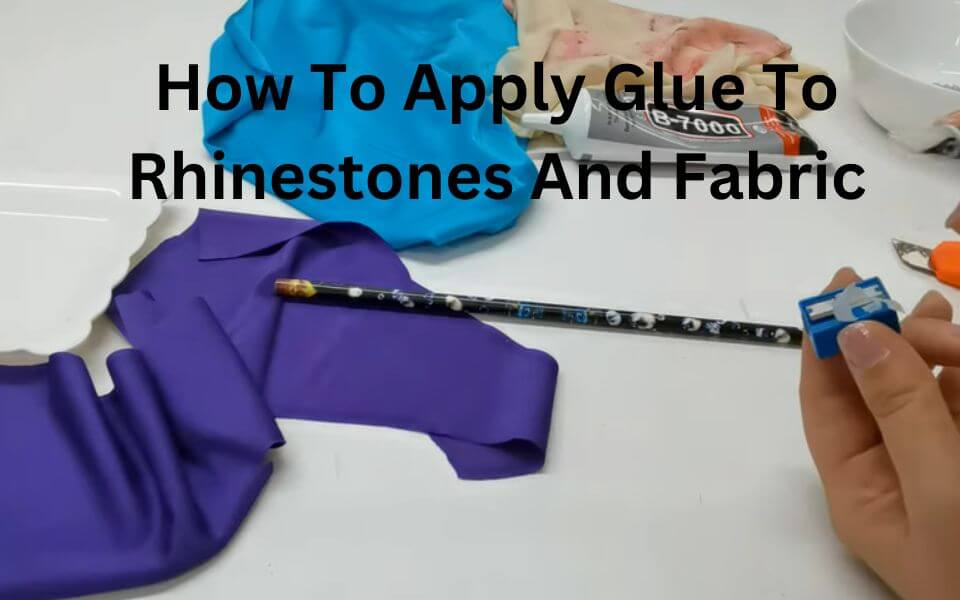
Attaching rhinestones to fabric is a meticulous process that, when done correctly, results in a stunning, professional finish. Here’s a step-by-step guide on how to apply rhinestones to fabric, ensuring each gem is perfectly placed and securely fastened.
Step-by-Step Guide:
- Prepare The Fabric:
- Start by cleaning the fabric to remove any oils or debris.
- The fabric should be dry and ironed if necessary to provide a smooth surface.
- Gather Your Materials:
- Have your rhinestones, the best glue to attach rhinestones to fabric, tweezers, a toothpick, or a specialized applicator
- Then, a piece of wax paper or a disposable plate to dispense glue on hand.
- Dispensing The Glue:
- Squeeze a small amount of glue onto the wax paper or plate.
- You’ll use this as your glue palette to prevent over-applying directly on the fabric.
- Picking Up The Rhinestones:
- Use tweezers or a rhinestone picker to carefully pick up a rhinestone.
- Avoid touching the back (glue side) of the rhinestone as oils from your hands can affect adhesion.
- Applying The Glue:
- Dip a toothpick into the glue and apply a small amount onto the back of the rhinestone.
- Alternatively, if the glue has a fine-tip applicator, you can apply a tiny dot directly onto the fabric where you’ll place the stone.
- Placing The Rhinestone:
- Gently press the rhinestone onto the fabric in the desired position. Do not push too hard, as this can cause the glue to spread beyond the edges of the stone.
- Adjusting If Necessary:
- If you need to adjust the placement of the rhinestone, do it quickly before the glue sets. Use the dry end of a toothpick to nudge the stone into place.
- Letting It Set:
- Allow the glue to dry according to the manufacturer’s instructions. Avoid moving the fabric or handling the rhinestones during this time.
Tips For Precise Application:
- Use the Right Tools: Precision tools like tweezers and toothpicks or a rhinestone setter can significantly improve the accuracy of your application.
- Test First: Always do a test run on a scrap piece of fabric to ensure that the glue works as expected and that you’re comfortable with the application process.
- Keep it Clean: Any excess glue can be cleaned up with a damp cloth before it dries, but be careful not to disturb the stones.
- Perfect Placement: Create a guideline or pattern on the fabric with a fabric pen that can be easily removed or will not show once the stones are applied.
However, by following these steps and tips for rhinestone glue application, your project should come together seamlessly, showcasing a professional touch that enhances the overall design. Remember, patience and precision are key when working to apply rhinestones to fabric and selecting the right adhesive is fundamental to achieving a long-lasting result.
DIY Projects Featuring Rhinestones
The sparkle of rhinestones can transform everyday items into unique, personalized treasures. Whether you’re jazzing up a pair of jeans or adding a touch of glamour to home décor, the best glue to attach rhinestones to fabric will ensure your project has a professional finish and holds up over time. Below are some creative DIY projects to inspire your next craft session, along with tips on choosing the right glue based on the fabric type.
Creative DIY Ideas:
- Customized Denim Jackets:
- Turn a plain denim jacket into a statement piece with rhinestone embellishments.
- Create patterns or spell out words for a personal touch.
- Bridal Wear Accents:
- Add elegance to a bridal veil or the hem of a wedding dress with delicate rhinestone details.
- This is where a clear-drying, flexible glue is vital.
- Rhinestone Throw Pillows:
- Enhance your living room or bedroom décor with throw pillows featuring rhinestone designs.
- Use patterns that complement your interior style.
- Embellished Tote Bags:
- Give a simple canvas tote a facelift with bold rhinestone designs.
- This is a perfect project for beginners.
- Rhinestone Sneakers:
- Step up your footwear game by decorating sneakers with rhinestones for an extra bit of flair.
- Decorative Table Runners:
- Impress guests with a homemade table runner adorned with sparkling rhinestones, perfect for special occasions.
Choosing The Right Glue For The Fabric Type:
- Denim & Heavier Fabrics:
- A strong, permanent glue that can penetrate thicker fabrics is necessary for materials like denim.
- Look for adhesives labeled as heavy-duty or industrial-strength.
- Tulle & Sheer Fabrics:
- For delicate fabrics used in bridal wear or veils, a glue that dries clear and doesn’t stiffen the fabric is essential.
- Water-based glues often work well for these applications.
- Cotton & Canvas:
- These porous fabrics absorb glue, so you need a thick, viscous adhesive that won’t seep through too much, potentially staining the front of your project.
- Synthetics & Stretchy Materials:
- When working with synthetics or stretch fabrics, opt for a glue that maintains flexibility once dried, to move with the fabric.
- Leather & Suede:
- Special leather glues are available that bond well without damaging these specialty fabrics.
Every project is unique, and the best glue to attach rhinestones to fabric will depend on the type of fabric you’re working with as well as the use of the finished product. Always consider the weight of the fabric, the desired durability, and whether the item will be subjected to washing or heavy wear.
By showcasing these DIY projects and discussing the importance of choosing the right adhesive, we hope to inspire both novice and experienced crafters to explore the dazzling world of rhinestone embellishment.
Preserving Your Rhinestoned Fabrics
Creating a rhinestone-embellished fabric piece is just the beginning; maintaining its sparkle and ensuring the gems stay in place over time is where the real challenge lies. The longevity of your creation heavily relies on the care and maintenance post-application. Here, we offer advice on preserving your rhinestoned fabrics, from washing to everyday handling, to help you enjoy your dazzling designs for years to come.
Care And Maintenance Tips:
- Washing Rhinestoned Garments:
- Turn the garment inside out before washing to protect the rhinestones.
- Use a gentle cycle with cold water to prevent the glue from softening.
- Avoid bleach and fabric softeners, which can degrade the adhesive used to attach the rhinestones to the fabric.
- Drying The Garments:
- Air drying is preferred. Lay the item flat or hang it to prevent the stones from dislodging under weight.
- If you must use a dryer, opt for the lowest heat setting and remove the garment while still slightly damp to air dry the rest of the way.
- Ironing:
- Never iron directly over rhinestones. Always turn the garment inside out, and use a pressing cloth between the fabric and the iron to avoid heat damage.
- Use a low heat setting and avoid steam, which could affect the adhesive’s hold.
- Storage:
- Store rhinestone-embellished clothing separately to avoid scratching or snagging the stones on other items.
- Wrap the items in soft tissue paper and keep them in a cool, dry place.
- Handling & Usage:
- When wearing rhinestone-embellished clothing, be cautious of activities that may cause stones to snag and detach.
- Inspect the garment before and after each use for any loose stones and re-attach them with the best glue to attach rhinestones to fabric if necessary.
- Professional Cleaning:
- For high-end or intricate rhinestone pieces, consider professional cleaning. Professionals have the right tools and expertise to clean such items without causing damage.
With these tips in mind, your rhinestone-embellished fabrics will maintain their beauty and integrity. The choice of the best glue to attach rhinestones to fabric plays a significant role in this, as high-quality adhesives can withstand the wear and tear of regular use and cleaning. Careful handling and maintenance ensure that your sparkling designs continue to shine, making every effort you put into your project worthwhile.
Troubleshooting Common Issues With Rhinestone Fabric

Even when using the best glue to attach rhinestones to fabric, crafters may occasionally run into some challenges. Knowing how to address these common issues will save your project from potential disaster. Here’s a troubleshooting guide for the most frequent problems encountered during and after rhinestone application.
Common Problems and Solutions:
- Rhinestones Falling Off:
- Cause: Insufficient glue, excessive handling before the glue cures, or using the wrong type of glue for the fabric.
- Solution: Re-attach using the correct amount of glue and allow adequate drying time. Make sure to use the right adhesive for your fabric type.
- Glue Stains on Fabric:
- Cause: Excess glue spreading beyond the rhinestone or using a glue that isn’t clear-drying.
- Solution: Gently wipe away excess glue before it dries with a damp cloth. For future applications, apply a smaller amount of glue and use a precision tool for placement.
- Rhinestones Not Lining Up Properly:
- Cause: Misalignment during the application or shifting before the glue sets.
- Solution: Quickly adjust the rhinestones while the glue is still wet. Use a template or marking method to ensure correct placement from the start.
- Changes In Fabric Texture After Gluing:
- Cause: Some glues can stiffen the fabric around the rhinestones, affecting drape and flexibility.
- Solution: Select a flexible fabric glue designed to maintain the natural hand of the fabric, especially important for garments.
- Removing Rhinestones:
- Cause: Mistaken placement or a desire to change the design.
- Solution: If the glue has not set, quickly reposition the rhinestone. For dried glue, carefully apply a solvent that can loosen the adhesive without damaging the fabric, and gently remove the stone.
- Repairing Rhinestone Fabric:
- Cause: Wear and tear over time may lead to loose or missing stones.
- Solution: Secure loose stones with a dab of the best glue to attach rhinestones to fabric and replace missing ones by selecting stones of the same size and color.
However, using the right techniques and addressing these issues promptly, your rhinestone designs can remain intact and look great. Whether you’re a seasoned crafter or a DIY novice, knowing how to troubleshoot can greatly enhance your crafting experience. Remember, the key to avoiding most of these issues lies in the choice of adhesive. A high-quality rhinestone glue that is appropriate for the fabric and the intended use of the item is critical to your project’s success.
FAQs
When it comes to adding a touch of sparkle to fabric, some common questions arise about the process. Below, we answer these queries, incorporating the best glue to attach rhinestones to fabric and related terms to enhance understanding and SEO performance.
Q-1: What is the best glue to attach rhinestones to fabric for washable items?
Answer: For washable items, the best glue to use is specifically labeled as washable or permanent fabric glue. These adhesives are designed to survive multiple wash cycles without losing their bond. Examples include E6000 Fabric Fuse or Gem-Tac, as they hold up well and remain flexible after drying, which is crucial for maintaining the integrity of both the rhinestones and the fabric through washes.
[amazon box=”B00CB3BZBW” description=”None”]
Q-2: How long does rhinestone glue take to dry on fabric?
Answer: Drying times can vary depending on the type of glue used. Typically, a rhinestone glue may take anywhere from 10 minutes to an hour to set to the point where the rhinestones won’t move, and 24 to 72 hours to fully cure. Always check the manufacturer’s instructions for specific drying times. It’s important to allow the glue to dry completely to ensure the strongest possible bond.
Q-3: Can you use hot glue to attach rhinestones to fabric?
Answer: Hot glue is not generally recommended for attaching rhinestones to fabric. While it can provide a strong hold, it tends to be too thick, which can result in a messy application. Additionally, hot glue is not as durable or flexible as other adhesives and may not withstand washing or wear. It’s better to use a glue specifically designed for fabric and rhinestone application.
[amazon box=”B09NLH5HFW” description=”None”]
Q-4: Is there a difference between gluing rhinestones on stretch vs. non-stretch fabric?
Answer: Yes, there is a difference. When attaching rhinestones to stretch fabric, you need an adhesive that will stretch with the fabric and maintain its hold without cracking. For non-stretch fabrics, the glue doesn’t need to be as flexible. When working with stretch fabrics, look for glue labeled for use on flexible materials.
Q-5: How to remove excess glue from fabric without damaging rhinestones?
Answer: To remove excess glue from fabric, gently scrape off the excess with a toothpick or the edge of a credit card. If the glue has dried, placing a piece of cloth over the glue spot and gently ironing on a low setting can help loosen it. You can also use a specialized fabric glue remover or a small amount of acetone on a cotton swab for stubborn residue. Be very careful to avoid contact with the rhinestones, as solvents may damage their backing or alter their appearance.
Q-6: How do I properly apply glue to rhinestones?
Answer: Apply a small amount of glue to either the back of the rhinestone or directly onto the surface where it will be placed. Then, gently press the rhinestone onto the glue, ensuring full contact. Wipe away excess glue.
Q-7: How does surface preparation affect the adhesion of glue to rhinestones?
Answer: Proper surface preparation, such as cleaning and drying, can significantly improve the bond between the glue and rhinestone. Dirt, dust, or oils can inhibit adhesion, leading to a weaker bond.
Q-8: What factors should I consider when selecting glue for rhinestones?
Answer: Make sure you know what material you are adhering the rhinestones to, as some glues are more compatible with certain surfaces than others. There are also factors such as the glue’s drying time, its color when dry, its strength of adhesion, its flexibility when dry, and its water resistance.
Q-9: What’s the best glue for rhinestones on plastic?
Answer: As for adhering rhinestones to plastic, you’ll need an adhesive that adheres well to non-porous surfaces while being flexible enough to withstand bends and movements. Again, E6000 is a great glue for gluing rhinestones. Although Gem Tac also works well for gluing rhinestones and can be used on porous & non-porous surfaces, including plastic. As soon as it dries, it becomes clear & flexible.
Q-10: What’s the best glue for rhinestones on shoes?
Answer: To attach rhinestones to shoes, it is necessary to choose a glue that is sturdy, flexible, & waterproof. Due to the amount of wear & tear shoes undergo and the weather conditions they can experience.
[amazon box=”B07MWRV574″ description=”None”]
Q-11: What’s the best glue for rhinestones on metal?
Answer: The G-S Hypo Cement and the E6000 Craft Adhesive are both popular choices for adhering rhinestones to metal. Both are known for their industrial strength & flexibility, which makes them durable, water resistant, and temperature-resistant. They are also clear when they die, making it an excellent choice when it should be invisible.
[amazon box=”B00C7PA7UY” description=”None”]
Q-12: What is the most versatile rhinestone glue?
Answer: Gem-Tac, which is the classic Tacky Glue for jewelry making and repair, is a must-have for every crafter. With Gem-Tac, you can buy it individually or in a pack of 6 tubes. Each tube comes equipped with a precise applicator nozzle, ideal for gluing delicate items, such as placing a crystal individually. Tacky glue is a water-based adhesive, making it ideal for items that won’t be washed with soap & water.
[amazon box=”B08GYRWBVJ” description=”None”]
Q-13: What is the Best Rhinestone Glue for Cardboard?
Answer: Beacon Gem Tac is recommended for cardboard by experts. The reason is that it sticks to the cardboard better than any other adhesive and it doesn’t emit a lot of odor, so when you’re working for hours on end, it’s a great choice!
Final Thoughts
Choosing the best glue to attach rhinestones to fabric is not just a minor detail; it is the foundation of ensuring that your sparkling creations withstand the test of time and use. Whether you’re embellishing a dance costume, upcycling a denim jacket, or adding flair to home textiles, the right adhesive means your rhinestones stay secure, and your fabrics maintain integrity.
We’ve explored the different types of adhesives suitable for various fabrics and the importance of considering factors like flexibility, drying time, and the fabric’s washability. Remember that for washable items, a permanent fabric glue that can survive the rigors of a washing machine is essential, while stretchable fabrics demand an adhesive that moves with the material.
Now, with your toolkit of tips, care guidelines, and troubleshooting solutions, go forth and create—your imagination is the only limit. Happy Crafting.
